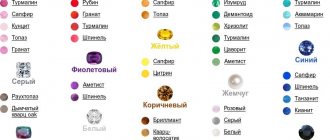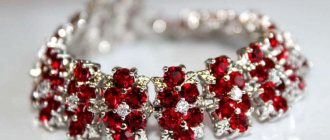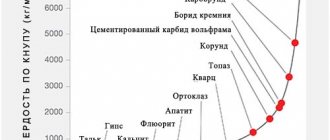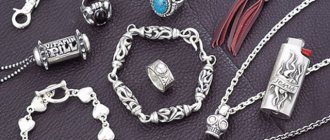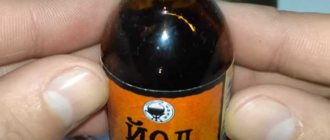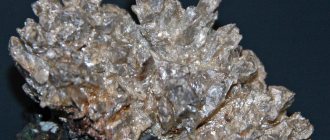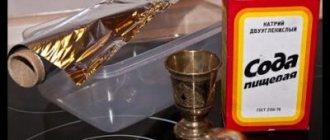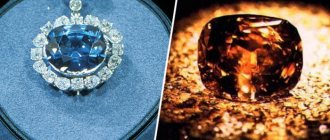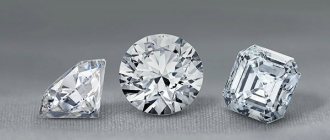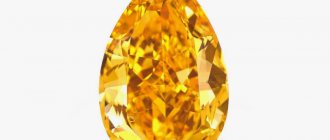Diamond, being the hardest gemstone, confidently holds the championship in the Mohs mineralogical hardness scale.
Despite its significant cost, a diamond has always been a desirable acquisition for every woman. Unscrupulous sellers still do not neglect this circumstance, actively offering counterfeit gemstones on the market. That is why every potential buyer should know how to distinguish a real diamond from a doublet.
There are several misconceptions about how you can quickly verify the authenticity of a stone.
Myth No. 1. If he scratches the glass, it doesn't mean anything.
There are other stones, for example moissanite, which is superior to glass in terms of hardness. It also leaves a mark on the glass surface.
Myth No. 2. A diamond is so hard that it cannot be broken.
A good blow from the hammer will shatter the stone into small pieces. Also, you should not test the stone with sandpaper. If you get your hands on a diamond-coated material, the surface of the stone will be scratched.
Myth No. 3. If you breathe on a diamond, it will not fog up.
It has been proven that a diamond can dissipate heat directed at it. Based on this conclusion, this myth arose. In fact, condensation forms, but does not stay on the surface for long.
Another artificial rival to the diamond.
Moissanite is a stone obtained by mixing silicon with carbon under high temperature.
- Moissanite is often mistaken for a diamond due to its brilliant shine. Due to its high refractive index, moissanite sparkles approximately 25% more than diamond.
- The dispersion index, that is, the play of light, is also more than twice as high in moissanite as in diamond.
- The purity of moissanite is higher - various impurities may be present in the diamond.
- When exposed to ultraviolet light, a diamond will have a bluish glow, while moissanite may reflect grey, green or yellow. This method is not always justified, since ideal stones do not create this effect.
- The presence of double refraction, when the light passing through the stone is split into two, indicates that it is moissanite and not a diamond.
- The price of a diamond increases in proportion to the square of its mass. A 2 carat diamond will cost the same as 4 1 carat diamonds. The price of moissanite for 1 carat is unknown, it all depends on its total weight and color. In most cases, it ranges from 1 to 5% of the cost of large natural diamonds with similar characteristics.
But still, it is practically impossible to distinguish these stones from each other at home.
Technologies for creating artificial materials and growing synthetic analogues of natural stones are progressing. Having the same properties and structure, they cannot be distinguished “by eye” from precious stones. In such cases, to identify a synthetic stone, professional expertise is needed, which is carried out using serious equipment, and the researchers have deep knowledge and skills. Currently, the instrumentation base of the Hematology Center of Moscow State University makes it possible to determine all types of stone refining that are found on the market.
Evaluation of stones is not limited to determining their mass. Diamonds have gradations in color, clarity, and cut quality. Diamonds are assessed according to Russian and international systems.
Independent gemological examination is the only way to protect against counterfeits.
BENDES studio experts described several effective ways to verify the authenticity of diamonds:
It is advisable to use not one of them, but several.
- When purchasing, you should immediately check for a certificate, which will be the first check of the stone for its authenticity. When issuing a certificate, experts determine its main characteristics: color, clarity, weight, cut quality. To check the certificate itself, its number must be entered on the official website of the company that issued it. We wrote more about the certificate and performance requirements in the article How to distinguish a genuine GIA certificate from a fake?
- For diamonds, it is important that real, not exaggerated color and clarity characteristics are indicated. For each diamond, the seller must have an appropriate certificate and an expert opinion. In the expert opinion, you need to pay attention to the weight, size, type of stone (natural or refined), a diagram of internal and external characteristics, expert signatures, laboratory details and contacts, and a counterfeit-proof hologram of the form. The number and date of issue are confirmed on the laboratory website.
- When purchasing a product, you need to find out the number of faces in the stone. The classic diamond cut has 57 facets. If the number of faces is smaller, then the glow and refraction deteriorate. Small diamonds of this cut are inferior to cubic zirconia.
- The quality of the cut is determined using complex measurements and tables. The buyer can define it as follows: the cut is bad if the stone does not shine.
- When you hold the stone in your hand, it will not immediately heat up, but will remain cool at first.
To distinguish a stone at home:
- Test with a glass of water: if you throw a gem into water, it will immediately sink to the bottom. The glass imitation will float on the surface.
- Temperature contrast: the stone should be heated over an open fire for 30 seconds, then sharply lowered into a glass of ice water. After cleaning a diamond, you will not find a single change. Any other mineral, including imitation diamond, will turn into crumbs, crack, or other defects will occur.
- Drawing experiment: draw a line or a cross on a piece of paper with a pen and place a stone on it. If the design is visible through the stone, it is not a diamond. But it should be noted that moissanite will pass the test.
- If you have a 10x magnifying glass handy, you can look at the inclusions. If the inclusion resembles a fine hair or a long thin scratch, it is not a diamond, but moissanite or cubic zirconia. Possible inclusions of diamonds are described in the article
BENDES clients
Laysan Utyasheva
Russian athlete, Honored Master of Sports in rhythmic gymnastics, TV presenter and sports commentator.
Oksana Fedorova
Russian TV presenter, philanthropist, fashion model, actress and singer. Miss Russia (2001) and Miss Universe (2002).
Lera Kudryavtseva
Russian television and radio presenter, actress, dancer. She worked for Muz-TV, TNT, TV-6 and NTV.
Natasha Koroleva
Russian singer, actress and fashion model. Honored Artist of the Russian Federation (2004).
Alexander Revva
Russian showman, comedian, TV presenter, singer. Resident of the Comedy Club show.
Exhale on the stone
If you exhale hot air directly onto the stone, you can quickly tell if it is real. The fake will become slightly foggy for a short time, like a bathroom mirror. A real diamond will remain sparkling because it does not retain heat. This is a very simple and at the same time very effective method that will not damage artificial stone, if for sentimental or some other reasons you do not want to spoil it with sanding paper.
Zircon variety
Looking at a photo of a gem, you can see how varied in color specimens can be found. Experts divided all the stones into groups and gave each a name depending on the predominant shade:
- Hyacinth is a mineral in which orange, red, and brown colors predominate.
- Jargon - translated from Persian this name sounds like “golden”. This variety has a yellow, slightly golden or warm straw hue.
- Matarsky is a colorless crystal that gets its name from its place of origin. The deposit is located in the depths of the island of Matara, located on the southern coast of Sri Lanka. The transparent stone is one of the most expensive on the jewelry market.
- Starlite - this variety is obtained by firing at high temperatures. This allows you to change the original color, and the stone becomes bluish. Many gems take on a delicate purple tone.
- Malakon is a rich brown or even black mineral. It contains a small dose of radiation. Many people are mistaken in thinking that such a stone is harmful to humans; experts have proven that the radiation that it contains is completely safe.
- Matur diamond is a white stone that is almost impossible to find in nature. It gets this color after heating colored stones.
You can also find a green stone. It acquires this shade thanks to the uranium it contains. The tint palette includes tints of light green, rich emerald, and turquoise. The spring green color of the stone also attracts many connoisseurs of beauty. Uranium makes the gem radioactive, but this element contains in very small quantities and is not harmful to humans.
The cost of a cut gem is determined by many indicators. The residual amount is affected not only by the weight of the stone, but also by the color of its edges. It is worth noting that all varieties of the mineral look great in finished jewelry.
Therapeutic properties of the mineral
From the moment they met the stone, people were delighted not only with how the gem looked, but also with how powerful the energy it possessed. Healers used it for treatment, and even today lithotherapists recommend that patients not ignore the beneficial properties of zircon.
The stone is capable of:
- alleviate colds and other diseases affecting the respiratory system; minerals of dark shades are better suited for this purpose;
- normalize hormonal levels;
- help control weight: yellow zircon will increase appetite, and yellow zircon will reduce it;
- improve the functioning of the digestive system;
- strengthen blood vessels and the heart, for this it is better to choose stones of reddish tones;
- speed up the recovery process after injuries and operations.
Of course, it is important to remember that such therapeutic effects can only be felt in minimal manifestations. Alternative medicine methods should only complement conservative therapy, but not become the basis of treatment.
Professional authentication methods
When combining different home testing methods, the result is most likely to be correct. However, there are cases when the fake is made so well that it is impossible to do without the help of special equipment and expert knowledge. The hardest thing is to distinguish between diamond and moissanite, but cubic zirconia sometimes confronts a person with a non-trivial task. In general terms, we will convey how professionals work in such cases.
By reflection
The specialist takes a special device and analyzes the crystal. Diamond, glass, cubic zirconia or other material will have different reflection coefficients. This cannot be determined by eye, and the necessary device costs a lot.
By conductivity of electricity
Synthetic stones are semiconductors, meaning they conduct electricity. Experts have equipment that allows them to evaluate the degree of conductivity and make a conclusion about whether the stone is real.
Using a microscope
This magnifying device will allow you to see what is hidden from the most powerful magnifying glasses. The smallest defects, cutting features, sharpness of edges - these signs will indicate authenticity or fakeness.
Through an electron microscope you can see the grain structure of the crystal. In synthetic stones, at this magnification, clusters of microscopic-sized single crystals are visible. They seem to have grown together. In natural materials, single crystals are faceted.
Another option is to combine a polariscope with a microscope, and then in polarized light you will see “copies” of the seed crystal. Any single crystal, no matter how it grows, will repeat the shape of the seed. And the seed itself will be visible as a darkened zone in the middle of the former uncut crystal.
